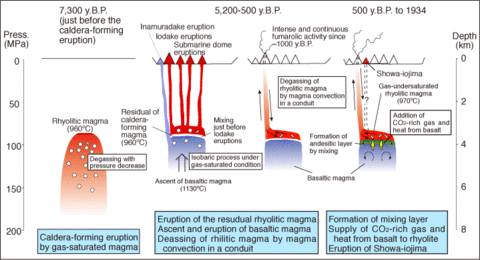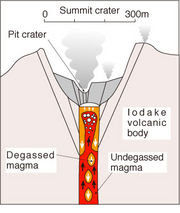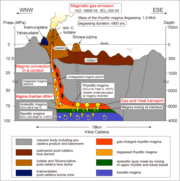Magma system
火山研究解説集:薩摩硫黄島 (産総研・地質調査総合センター作成)
| Contents: Satsuma-iojima |
|---|
- Model showing evolution of magma reservoir
Introduction
At Satsuma-iojima vigorous volcanic activities have continued even after the formation of huge caldera about 7,300 years ago. A large amount of magma (over 19 km3) has erupted within caldera which is mainly submarine. It is believed, therefore, that a large underground magma reservoir exists even after the caldera was formed.
At Iojima after the caldera formation, Iodake and Inamuradake peaks were created with eruption and high temperature gas of 800-900℃ has been continuously emitted from Iodake. The gas is mostly magmatic in origin.
The amount of gas reaches 1,300 tons per day estimated from measurements of emitted sulfur dioxide (SO2). To continue emittance of such huge amount of gas from the magma, enormous amount of magma has to degas.
In this chapter, an interpretation of the movement of underground magma from 7,300 years ago to this day is presented.
Activities of the magma
As the temperature of volcanic gas emitted from the Iodake summit crater is very high (up to 800-900℃) it is estimated that the gas reaches ground surface immediately after separation from the magma. In other words the magma seems to be present close to the ground surface.
Ninety-seven percent of the high temperature volcanic gas is steam. As water is readily dissolve in the magma, emission of water only occur if the magma is at comparatively low pressures. This further suggests that the magma exists close to the ground surface.
The amount of water discharged from the magma is estimated to be about 40,000 tons (equivalent to a liquid water cube with sides of 34 m at room temperature under one atmospheric pressure) per day based on the chemical and isotopic compositions of the gas and amount of SO2 emitted. For this much of water is to be discharged the actively degassing magma should exist at shallow depths.
The question is how much magma at what depths degassing.
The answer can be given from estimation of original amount of gas contained in the magma. Here only the conclusion is shown, but it is over 4 million tons of magma degassing every day at about 20 atmospheres pressure.
The pressure is equivalent of several hundred meters depth at Iodake summit crater. As the height of Iodake is 704 m, degassing must be occurring above sea level. According to observations with broad band seismograph the tremors probably related to the degassing are centered above sea level. Therefore it seems that the magma head (top of magma column extended from magma reservoir at depths) is located at this level and degassing has been occurring there. Calculated amount of the magma from which degassing occur is equivalent of a 100 m cube per day. This corresponds to 0.3 to 0.4 km3 magma degassing per year.
Mechanism of degassing
Referring to the old documentation such as the Story of Heike as well as the degrees of alteration of rocks, it is believed that huge amount of degassing has continued over 1,000 years. Even the facts that long-term variation of degassing (strictly speaking the amount of degassing before 1970s when observation of degassing began is not known) and possible differences of gas compositions depending on different magmas (it is understood that two types of magma exist underground) are taken into account, the total amount of degassed magma must be over 100 km3 in the last 1,000 years.
No evidence is available for existence of this much magma at such shallow depths. A large amount of magma can only exist at great depths. For a large degassing to occur, the magma should be at low pressure environment.
This dilemma can be explained by a process of magma convection in a conduit. If a conduit connects low pressure environment at shallow depths with a magma reservoir at depths, the magma can rise through the conduit and is brought to low pressure environment. As degassed magma has higher density than non-degassed magma it can sink back to the reservoir. This process is repeated resulting in a large amount of magma degassing.
Current magma reservoir
As was mentioned earlier, a large amount of magma (over 19 km3) erupted since the formation of caldera. Also degassed magma not erupted and stayed underground is estimated to be over 100 km3. Therefore, it is concluded that a large magma reservoir must have existed constantly continuing eruptions even after the formation of caldera 7,300 years ago.
New questions arisen here are where such magma reservoir is, what the nature of it is, and how it behaves.
Based on petrological analyses, analyses of gas compositions contained in the melt, geochemical analyses of the gas, and geophysical observations, the image of the magma reservoir is gradually emerging as shown in the left figure.
The upper surface of the magma reservoir is estimated to be at about 3 km depth, and it consists of basaltic magma at the bottom overlain by rhyolitic magma at the top with the intermediate portion consisting of andesitic magma from mixing of the basalt and rhyolite. Basaltic magma (1130℃) is hotter than rhyolitic magma (970℃) and richer in volcanic gas supplying the gas to rhyolite magma. Discharge of a large amount of gas mentioned earlier is due to the rise of rhyolitic magma through the vent and degassing near the ground surface. Degassed rhyolite magma sinks back to the bottom of the rhyolite layer and the gas is replenished through andesitic magma from underlying basaltic magma. In other words, most of the gas emitted from the surface is originated from basaltic magma existing at great depths.
Evolution of magma reservoir
Process of how the magma reservoir was formed is interpreted next.
Rocks and melt inclusions since the formation of the caldera about 7,300 years ago to the eruption of Showa-iojima in 1934-1935 have been closely examined and an image of magma reservoir evolution shown in the right figure has emerged.
Immediately before the caldera-forming eruption, a large rhyolite magma reservoir existed at 3-7 km depths. Rhyolite magma erupted through catastrophic outburst.
Part of rhyolitic magma escaped from erupting and remained in the reservoir. From the analyses of the rocks, a rise of basaltic magma to the bottom of the rhyolitic magma reservoir is suggested. Rhyolite eruption occurred about 5,200 years ago and formation of Iodake began. About 3,000 years ago basaltic magma started to erupt to form Inamuradake.
Rhyolite magma restarted erupting about 2,200 years ago and continued till 500 years ago with the formation of current Iodake dome. During this Iodake forming activities it is suspected that a basaltic magma reservoir existed beneath the rhyolitic magma reservoir. Within the rhyolitic magma reservoir, emission of volcanic gas became active by magma convection in a conduit. This continues to this day. After the last Iodake eruption (about 500 years ago), basaltic magma intruded into rhyolitic magma reservoir with resultant formation of mixed andesitic magma. In the eruptions of 1934-1935, rhyolitic magma with little andesitic magma formed Showa-iojima.
(Kohei KAZAHAYA・Genji SAITO)




